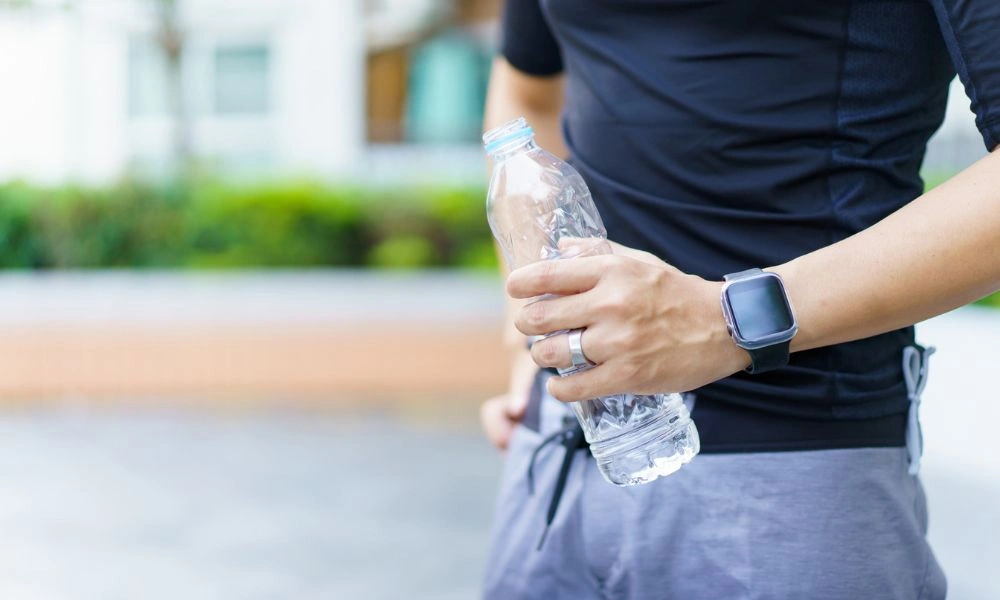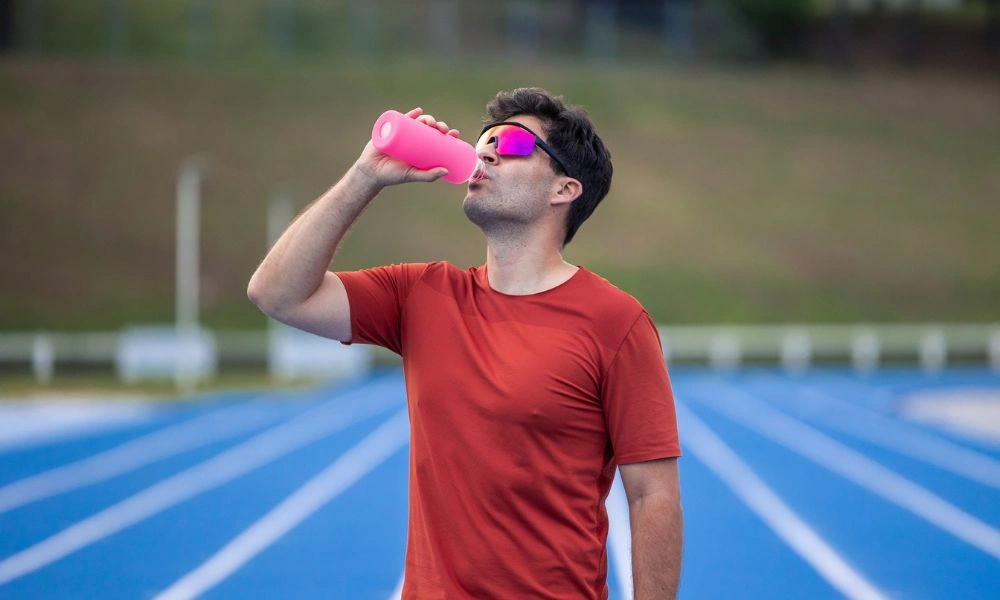Proper and timely hydration is crucial for a successful run, whether on a trail or asphalt, during training or competitions of any distance.
Without a systematic approach to fluid replenishment while running can result in various undesirable and potentially dangerous situations.
In this article, we’ll break down how much hydration affects running and how to drink during running, based not on scientific studies, but on practical experience and advice gathered from experienced runners across various distances.
Understanding Hydration
Hydration is the body’s ability to absorb, regulate, and control the water-salt balance of the whole body. According to science, consists of an average of 60% water.
The distribution of water percentage varies among the different systems within the human body, including the circulatory, muscular, and cerebral systems.
The body’s inherent ability, facilitated by the well-functioning “runner” brain that resides both in the brain and throughout the body, ensures a consistent fluid balance and the regular operation of all bodily systems. This is important during sports and before and after them.
Dehydration is the process of the body losing fluid and electrolytes.
Without this process, running is impossible since, during intense movement, a person loses fluid along with sweat, which is released to cool the body, and fluid loss occurs during intense breathing.
Several factors impact the rate and volume of dehydration:
- Air temperature and humidity
- Height above sea level
- The quality of acclimatization of the body to new natural factors
- Intensity of movement and pulse values
- Athlete’s level of training
- Preliminary preventive work
- Quantity and quality of equipment
As you already understand, the process of dehydration is absolutely inevitable for runners.
The slightest loss of fluid by the body is possible only with the confluence of several factors, such as a low, comfortable air temperature for running +7…+15°C, a minimal but comfortable amount of high-quality running clothing on the body, a light, refreshing breeze, comfortable air humidity, low running intensity (not a competition), short run duration, up to about 45 minutes.
This is what a light aerobic jog or recovery run looks like in mid-autumn.
Rehydration means refilling the body with fluids and electrolytes.
To stay adequately hydrated, it’s essential to have a plan, and that’s where the brain’s “runner” comes in, orchestrating the process.
The rehydration can be smooth and work well if there is a clear plan for how much and when to drink. This disorganized approach often causes different levels of dehydration. In severe cases, the effects can be primarily adverse but fixable.
Yet, in nasty situations or if something goes wrong, it could even result in severe consequences, including death.
It’s important to know that losing just 1% of your body fluid can make you feel dehydrated. So, when you run, make sure to drink enough water to avoid that parched feeling.
Losing 20-25% of your body fluid can be really dangerous and even lead to irreversible harm or death. Running’s goal is to boost your health and improve your life, not to harm it. Stay hydrated!
Dehydration + rehydration = normal hydration and a successful finish.
The runner’s responsibility is to strike a balance between losing and replenishing fluids, ensuring proper hydration throughout the activity.
The Risks of Insufficient Hydration

Dehydration happens when the body loses more fluid, typically through sweating, than it takes in through drinking (rehydration).
Feeling thirsty is a sign that dehydration has already started.
If you ignore this and don’t drink enough, your body will send other signals indicating it needs more fluid.
Early signs of dehydration include:
- Thirst
- Dry mouth
- Decline in energy
More severe signs of dehydration can include:
- Convulsions
- Headache
- Nausea
Severe dehydration is accompanied by hyponatremia and hypoglycemia, even though gels were consumed during the run.
Hyponatremia is a condition in which the body loses excessive sodium ions through sweat. White streaks on clothing or the body, a dry mouth, and increased thirst can be recognized. Muscle stiffness and fatigue may also be present, and in rare instances, cramps may occur.
Hypoglycemia is a drop in blood glucose levels below the normal range, and it can result from inadequate rehydration during exercise and a lack of proper nutrition.
Overhydration is the opposite process that occurs when the body takes in excessive fluids, particularly in attempts to address extreme thirst and dehydration.
How Much to Drink Before, During, and After Running?

Let’s agree that a healthy person can typically run for about 45 minutes without carrying water in average weather conditions. It’s usually enough to hydrate before and after the run.
Moreover, many well-trained athletes with considerable experience intentionally choose not to drink for extended periods during training.
This approach is a conscious effort to condition their bodies and enhance endurance, although it doesn’t mean they don’t bring water. Carrying water and using it are slightly different, and in their case, having it is more of a precautionary measure.
The amount of fluid needed depends on the duration of your run and how much you sweat. For runs lasting 45 minutes or more.
Here’s a general hydration plan:
On the day before a significant race or a lengthy workout, focus on nutrition and loading up on carbohydrates, as well as on fluid intake.
Drink your usual amount throughout the day, slightly exceeding it, and consider including isotonic drinks and electrolytes in your rehydration process.
- Before training or racing, drink 400-600 ml 1-2 hours before training, not in one fell swoop but gradually.
- While running, drink 150-200 ml every 15-20 minutes. Avoid feeling dry and thirsty! These are the first signs of dehydration.
- If the air temperature is consistently high, above +25°C, increase the frequency of consumption and add more electrolytes.
- Rehydration after exercise allows your body’s fluid levels to return to normal and promotes recovery.
Different Fluid Options for Hydration
Isotonic is a sports drink with a high electrolyte content. During intense exercise, the human body loses large quantities of electrolytes through sweat.
Water is suitable for short runs, as it does not cover all long-run fluid costs.
Cola is the simplest and most popular energy drink. It has a high sugar and caffeine content, which athletes need in trail races and long-distance runs.
Juices are an alternative to cola, but their sugar content is usually lower, which may not give you the desired strength-boosting effect. Citrus juice is good for cooling off in hot weather.
Tea with sugar and lemon is especially beneficial while jogging in the cold season. It quickly supplies the blood with glucose and gives you the strength to complete your workout.
Coffee. This drink is only relevant for very long-distance races, such as ultramarathons. It serves as a source of caffeine, necessary to excite the nervous system, increase concentration, and invigorate, which a runner needs during a long distance.
Recommended Water Bottle Options
A simple plastic bottle from different manufacturers is convenient for short-distance runs and can be put in a backpack or bag. However, plastic bottles are not reusable and must eventually be disposed of.
Sports plastic bottle the main thing is to choose containers made from proven food-grade plastic that do not emit harmful substances. Many athletes treat their usual “native” equipment with particular trepidation; for them, their bottle provides exceptional comfort.
A thermos is an option for long runs in the cold season, keeping drinks at a comfortable temperature. However, one problem is that it is not always convenient to take it with you.
Thermal tanks are made from environmentally friendly food-grade plastic and intended for reusable use. They eliminate the occurrence of harmful substances and foreign odors. They are conveniently attached to the waist using an adjustable waist belt not to interfere with the runner while moving.
It’s convenient to drink from the thermotank thanks to its wide neck, and when running, you don’t have to worry about liquid spilling out since the sealed screw cap closes securely, preventing leaks.
Hydration pack
The hydration pack is carried in running backpacks in a special compartment directly behind the back, if such a compartment is provided by the design, because only some running vests have one.
This is still the same soft tank made of more durable food-grade silicone than in bottles, and, as a rule, has a volume of 1.5 liters, rarely 2 liters. For this reason, in winter, it is delightful to pour hot tea or isotonic water into it.
A hydration pack is the most convenient option for those who need maximum running autonomy when there are vast distances between water sources.
Keep Drinking Available
Whether you’re running with a hand bottle, a belt, or a vest, water or sports drinks should always be on hand.
Try not to stop for a drink. If you stop, you’ll run slowly and are unlikely to stop enough to drink. During the hot season, be sure to take water with you when going for a run! This should be the rule without which no run can begin. It’s a matter of life and death!
Regardless of what temperature and climate that accompany sports, you need to drink. This is a question not only of results but also of maintaining health.
Some athletes deliberately practice training without water to learn how to store it and build endurance reserves. However, timely rehydration is essential for the health of every athlete, regardless of their level of training.
Drink correctly, and run for health!




